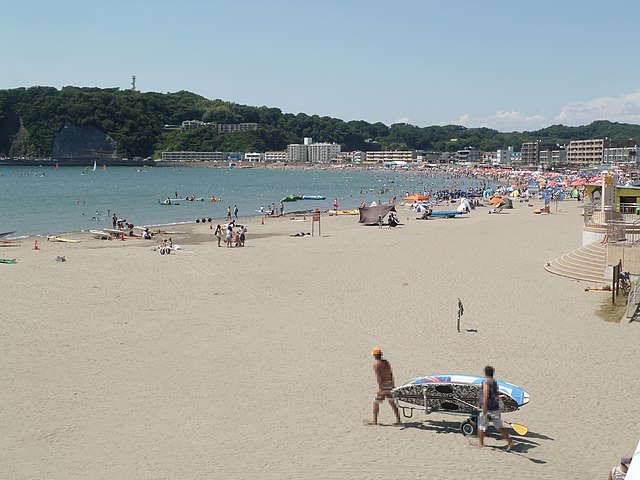Jul 24, 2023
Great Beaches in The Kanto Region
As the summer heat rises, retiring to your air-conditioned room with your necktie fan on full blast is tempting. However, Japan is an island nation, so we are surrounded by the sea and, thus, beaches. So leave that darkened room and head for the coast and the beach.
Beaches in Japan may seem like an alien experience on the first encounter. Very few people actually enter the water, no matter how inviting it is. The water is predominantly reserved for children and flirting students. Those who do make it into the water generally find it shallow – particularly at the artificial beaches – which makes the mass preponderance of floating devices somewhat confusing.
Most people prefer to stay on the shore under parasols or tents that are rented or brought from home (sunbathing is unusual), while for the more energetic, there are often rigorous beach games such as volleyball. Most beaches have small restaurants or huts selling food, snacks, and drinks (it is usually accepted to drink alcohol on Japanese beaches), and some places even have barbecue sections where you can grill your food. There is usually a lifeguard on duty and a beach house (umi no, i.e.) where you can shower and change. Some even have lockers in which you can leave your valuables.
Zushi Beach
Perhaps the most accessible beach to get to from both Tokyo and Shinjuku stations due to the frequent and relatively cheap train services to and from here, with stops in Kawasaki and Yokohama along the way. Once arriving at Zushi station, you won’t need to worry about so many details since the abundant shops, stands, and bars line the roads to the beach.
Getting there: Use the JR Shonan-Shinjuku or Yokosuka lines to get to Zushi station. You may also use Keikyu to Shin-Zushi as well.
Enoshima and Kamakura Beaches
The beaches of Kamakura are extremely popular in the summer months for visitors from Tokyo and Yokohama. This is for good reason. In addition to the sea and sand, the 4km island of Enoshima, a short train journey west (or even a beautiful coastal bike ride should you wish to rent bicycles), is a pleasantly touristy distraction with Enoshima Shrine, caves, and a nearby aquarium. Try the local shirasu fish delicacy.
Getting there: Access Kamakura, Yugigahama, or Katase-Enoshima stations.
99 beach
Ninety-Nine Beach is the colloquial name given to Kyujukyurihama on the eastern tip of Chiba. It’s known for its fantastic view of the first sunrise of the year, but it’s also a great place in the summertime. Because of its undersea topography and relatively strong onshore winds, you shouldn’t swim out of sight of the lifeguards, but the wide sandy beaches and occasional tasty seafood outposts make it a lovely day trip.
Getting there: Take the Wakashio Limited Express from Tokyo station or access Chiba Station, take the JR Sotobo line to Oami station, and catch the 大網02 bus to the beach.
Hayama-Isshiki beach
A holiday destination for Japan’s Imperial family since 1984, Hayama-Isshiki Beach is considered to be one of the best beaches in Japan thanks to its high-quality sand and the fact that it is less crowded than some of the other popular beaches. If you aren’t a fan of sand, there are lawns on which to loll, and if you want to get a bit sporty, then bodyboarding, windsurfing, and jet skiing are all allowed.
Getting there: JR Shonan-Shinjuku or Yokosuka Lines to Zushi station and change onto a Keikyu Bus number 12 (located to the left outside the ticket gates) bound for Hayama. Alight at Isiki Kaigan. One hour 30 minutes
Onjuku beach
The white semi-circle flat sandy beach of Onkjuku on the Boso peninsula is considered so beautiful that it has inspired a children’s song, represented by statues of camels carrying a prince and princess on their backs. Due to its fame, Onjuku is a particularly popular beach, especially amongst young adults who come to meet, surf, ride banana boats, and party with each other throughout the summer.
Getting there: Take the Wakashio line for Tokyo JR station towards Awakamogawa, and it is less than 90 minutes on a direct line to Onjuku.
Ōarai beach
Something of a tourist haven, the town of Ōarai attracts 3 million visitors a year, drawn to such attractions as water sports, the aquarium, the golf course, and the beach. With clear water, white sand, and surfers bobbing in the silver-crested waves, the Ōarai, and Sun Beach Bathing Beaches, are known for being some of the most pleasant in the Kanto region. They are shallow beaches that become extremely popular in the summer, with plenty of activities to keep you occupied. Camping facilities are available.
From Tokyo, take the Ltd Exp Hitachi route to Mito, from where you can take the Kashima Rinkai Railway to Ōrarai in under two hours.
Ubara beach
Ubara Beach was selected as one of Japan’s ‘100 Most Scenic Beaches’ thanks to its rocky outcrops and bright blue sea. Ubara Beach is a little light on the entertainment side of things – there are few public facilities and just a handful of small restaurants – but it more than makes up for it with its outstanding natural beauty. It’s not somewhere to come to party, but the shallow, peaceful waters are ideal for reflecting on the sheer splendor of Japan’s coastline. Being less crowded –and windy – than other spots, it’s a perfect place to bring the kids.
Getting there: In a little over an hour and a half, you can get from Tokyo to Ubara via Kazusa Ichinomiya using the Ltd. Exp Wakashio and JR Soboto lines.
Quercus acuta, CC0, via Wikimedia Commons


About the author